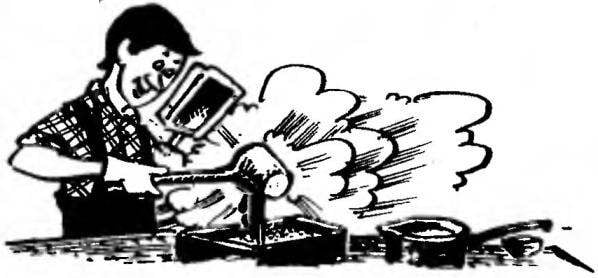Melting of metals is carried out as follows. First, using the small blade in the middle of the furnace in powder, make a hole, put it in the first portion of the metal and buried. If used scrap of various sizes, first place the largest piece, and only after melting it add small pieces.
To make sure that the metal is melted, the furnace may be lightly shake — the powder surface in this case also begins to sway. After cooling of the metal turned over and melted again. This is repeated several times until the workpiece will not accept more or less spherical form, certifying the quality of the melt.
When it is necessary to melt small chips or sawdust simple metals, they fall asleep right in the hole and melt as usual. More precious metal for safekeeping, placed in a glass vial under medication and melt along with it. Formed at the melt crust of glass sprinkled easily when cooling in the water.
Low-melting metals tin, aluminum and the like — is better placed in an iron Cup.
‘ To get the alloys first put in the powder, a refractory metal, and then melting is injected fusible. For example: copper + tin, copper + aluminium.
In the electric furnace to smelt tin, aluminum, iron, Nickel, copper, silver, gold, palladium. After melting the resulting blank are forging. They need to rashlebyvat on the anvil slowly, especially in the beginning, a small hammer. And as often as possible to heat the workpiece on a gas stove red-hot, then cool in cold water and then rashlebyvat to the desired size.
It is categorically impossible to melt magnesium, lead, cadmium, zinc and zinc alloys (zinc brass, cupronickel) as well as silver contacts from various types of relays, instruments, starters — they contain up to 50% of cadmium, which burn out, forming a yellow toxic smoke.
If you can not buy a powerful transformer, it can be replaced with composite. You need to take a slightly less powerful single-type transformers and in parallel to combine their output windings (assuming they are all designed for the same voltage). Possible and a homemade transformer. It is assembled from l-shaped permalien plates with an inner cross section 60×32 mm. Its network coil is wound enameled wire 1 mm thick and contains 620 turns. The reduction ratio of winding is wound with wire of rectangular section 4,2×2,8 mm and contains 70 turns.
With regard to safety when working with this oven, it is necessary to remember that welding transformer requires very careful handling. We can not allow there is a short circuit in the wires or between the electrodes in the furnace itself. The mains switch of the transformer should be placed close to any second it can be turned off. It is also a moment to leave a working stove unattended. There always must be a container of water, where we chill in the hot workpiece.
POPOV, Krivoy Rog, Ukraine
 Somehow in the course of working on one invention I needed a melting device with a wide range of heating, which would be convenient to use at home. I tried various options and electrospinning gas heaters and made sure that neither one nor the other suited to the task: they were either bulky and inconvenient to use, or didn’t provide enough heat. Here, I think, would be the electric arc melting, but operating at a slower pace!
Somehow in the course of working on one invention I needed a melting device with a wide range of heating, which would be convenient to use at home. I tried various options and electrospinning gas heaters and made sure that neither one nor the other suited to the task: they were either bulky and inconvenient to use, or didn’t provide enough heat. Here, I think, would be the electric arc melting, but operating at a slower pace!
